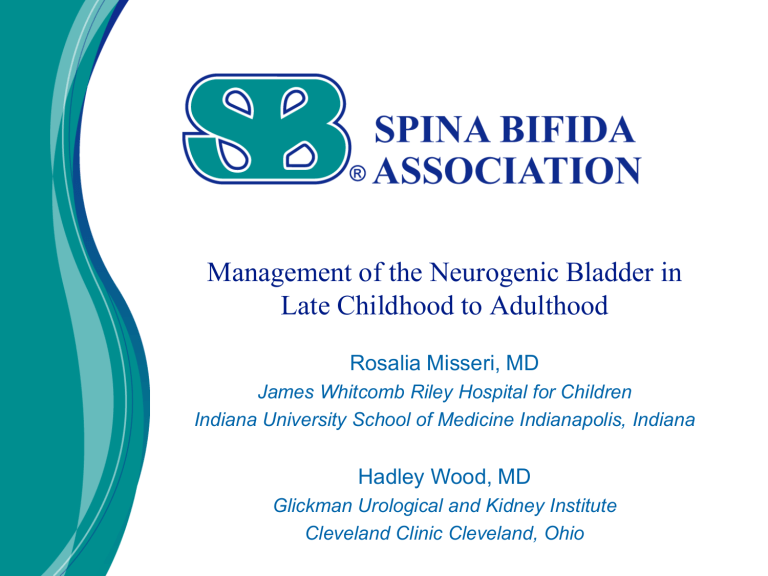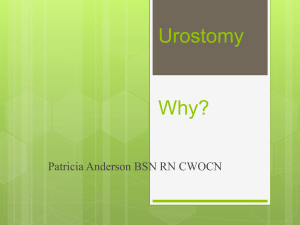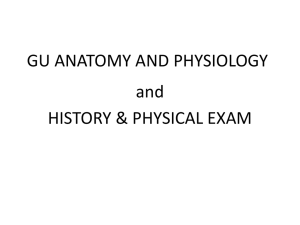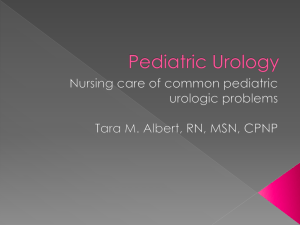Management of the Neurogenic Bladder in Late Childhood to

Management of the Neurogenic Bladder in
Late Childhood to Adulthood
Rosalia Misseri, MD
James Whitcomb Riley Hospital for Children
Indiana University School of Medicine Indianapolis, Indiana
Hadley Wood, MD
Glickman Urological and Kidney Institute
Cleveland Clinic Cleveland, Ohio
Overview
• What is transitional urology?
• When is it appropriate to consider transition?
• How to transition urological care
• Neurogenic bladder
– protecting kidney function
• Neurogenic bladder
– managing bladder function
Growing Up
• Children with spina bifida grow up to become adults
• Preparation for adulthood is essential
• Encourage them to look after themselves and take part in normal family life…from the beginning
Growing Up
• How do things change?
–Urologically
–Sexually
Growing Up
CHALLENGE
Transition of care for this growing population
Growing Up
– Renal failure remains the most common cause of death
– Pulmonary and cardiac disease are becoming more common
–Increased risk of atherosclerosis
Problem…
Finding a urologist who understands your problems!!!
TRANSITION
Transitional urology
• Subspecialty care with a focus on adolescents and adults with congenital anomalies or chronic urological issues
• Requires specialty expertise in:
– anatomy/congenital anomalies
– reconstructive urology
– knowledge of long-term effects of prior interventions/operations
Transitional Urology
• May also need support of social work or financial services to help patients navigate medical coverage issues
• Also functions as patient advocate/liaison for other subspecialists within urology and other specialties (cardiology, neurology, etc.)
Issues addressed at initial visit
• Current urological problems/needs
• Current living situation, work/school, and goals for the future
• Key players (care-providers, significant others, dependents) in patient’s life
• Quality of life concerns from parents/care-givers and patient
Issues addressed at initial visit
• Detailed review of prior surgeries/interventions, complications, and signed medical release for records
• Assessment of current status of the following:
– Renal function - Stone history
– Bladder management - Sexuality issues/goals
– Infection history - Fertility issues/goals
– Fecal continence history/goals
– Urinary continence history/goals
When is it appropriate to consider transition?
• Age alone is not a good criteria
• Patient, care-provider, pediatric urologist mutually agree that the urological issues are more “adult” in nature
• When the current urologist is uncomfortable or not capable of addressing the relevant issues
When is it appropriate to consider transition?
• When a urologist with subspecialty interest/expertise in transitional urological care can be identified
• The patient has a change of life (moving, new job, marriage, etc.) where it is reasonable to change medical care venue
How to transition urological care
• Discuss with key players
(family, care-givers, urologist)
• Gather records (and keep a copy) of all prior interventions, radiological and lab tests.
• Request a referral, consult SBA or other local resources for guidance
How to transition urological care
• Talk with other care providers
(cardiologist, neurologist, etc.)
• Think about and prioritize relevant urological goals/issues
• Bring someone with you who knows your history
• Request last appointment slot of the day or double-slot
NEUROGENIC BLADDER
• Urinary problem in which the bladder does not empty properly due to a neurological condition such as spina bifida
NEUROGENIC BLADDER:
Primary Goals for Management
The primary goal of the urologist is
always
to maintain and preserve renal function
What do the kidneys do?
–Filter the blood = eliminate waste
–Maintain acid-base balance
• Impacts growth & stone development
–Produce some hormones
• Impacts growth & puberty
–Help regulate blood pressure
–Regulate fluid balance by making urine
What can go wrong with the kidneys?
• Infections
• Hydronephrosis
• Stones
• Loss of function
What can go wrong with the kidneys?
• Infections
– Prophylaxis
• Prevention
– Treatment
• Treat when have symptoms
What can go wrong with the kidneys?
• Hydronephrosis
–Persistent
–New
• Changes in bladder dynamics
• Poor catheterization technique
• Blockage
What can go wrong with the kidneys?
• Stones
– Decreased mobility
– Calcium metabolism
– Electrolyte abnormalities
– Anatomical abnormalities
What can go wrong with the kidneys?
LOSS OF FUNCTION
• Renal failure was the most common cause of death in spina bifida patients in past
• Renal failure still occurs in spina bifida
• It can be prevented!
x
• Drink water
• Prevent infection
• Cath or void as directed
(TAKING CARE OF YOUR BLADDER TAKES CARE OF YOUR
KIDNEYS!!)
• Take your medicine
• See your doctor
– Check renal function, check bladder function
• Treat infections
Goals for the adolescent/adult patient with neurogenic bladder
• Prevent problems before they arise
• Identify which factors can be improved and which cannot
• Identify the risks of each line of treatment
• Balancing the risks and benefits of any treatment
Bladder function
Stores urine
Bladder Outlet
Stores urine
OUTLET
Bladder function
• May worsen due to outlet resistance or a tethered cord
• Outlet resistance increases
–Not always a positive
Bladder function: tethered cord
• 25% patients age 2-8
• Usually combination of new-onset neurological, orthopedic and urological problems
– 10% present with isolated new urologic problem
Bladder function: tethered cord
• Urologic symptoms:
• new onset of upper tract dilatation
(hydronephrosis)
• vesicoureteral reflux
• urinary incontinence
• urinary tract infection
• Treatment: cord release (surgery)
Bladder function: neurogenic bladder
• A bladder that stores urine at pressures that are too high to keep the kidneys from deterioration
• Requires consistent management
– Intermittent catheterization
– Anticholinergic medications
– Often both
– Usually first line therapy
Bladder function: neurogenic bladder
• RISKS
–End stage renal damage
–Social stigma and complications of incontinence
• GOALS
–Maintain healthy kidneys
–Continence
Bladder function: incontinence
Causes:
– Decreased outlet resistance
(sphincter)
– Bladder irritation (stone/infection)
– Increased bladder storage pressure (neurogenic bladder)
– Overflow
Bladder function: incontinence
• With aging, other risk factors can increase the risk for incontinence:
– Surgery of the prostate ( ♂ )
– Vaginal childbirth ( ♀ )
– Weight gain
Treatments of incontinence
• Behavioral: timed voiding, catheterization, avoid bladder irritants in diet
• Pharmacologic: anticholinergics
• Surgical:
– Decrease storage pressure
• Botox, bladder augmentation
– Increase outlet resistance
• sling, artificial sphincter
• Combination
Treatment of neurogenic bladder:
Intermittent Catheterization
• LONG TERM RISKS
– STRICTURE
0-20%
– TRAUMA
– EPIDIDYMITIS
• ACCESS
• SUPPLIES
Treatment of neurogenic bladder:
Anticholinergics
• SIDE EFFECTS
–Dry mouth
–Constipation
–Headache
• COST
–Only oxybutinin is generic
Anticholinergic Medications:
Treatment Considerations
• COST!!
• Frequency of dosing
• Characteristics to limit sleepiness
• Limitation of other side effects (constipation)
• Antispasmotic effect (intravesical oxybutinin)
• Drug interactions
• Delivery mechanism: oral versus topical/transdermal/intravesical
Treatment of neurogenic bladder:
Surgery
• Botox injection
– Endoscopic procedure/outpatient
– Onset within 2 weeks after treatment
– Effect lasts ~ 6 months
– Side effects rare and minor (<10%)
– Efficacy:
• Reduction from baseline incontinence: 40%-80%
• 65%-87% of patients became completely continent
(between caths) after Botox
– Main issue is cost/insurance coverage…
Treatment of neurogenic bladder:
Surgery
• Make the bladder larger/lower pressure
–Bladder augmentation
• Make the outlet tighter
–Sling, artificial sphincter
Treatment of neurogenic bladder:
Surgery
• Risks with increasing age
• Risks with increasing obesity
–Infection
–Cardiovascular status
–Pulmonary status
–Deep venous thrombosis
Treatment of neurogenic bladder:
Surgery
• Significant periods of immobility
• Difficulty positioning
• Difficulty accessing abdomen
• Potential for fracture
• Increased incidence of Latex allergies
• Decline in respiratory reserve
• Worsening scoliosis
Treatment of neurogenic bladder:
Surgery
• How do we decide what to do?
• Urodynamics
– Gives us an idea of bladder storage pressure
• > 40 mmHg is dangerous
– Gives us an idea of bladder capacity
• Low capacity means frequent voiding/ISC
– Gives us an idea of outlet resistance
• Tells us whether sling/sphincter can reduce leakage
Treatment of neurogenic bladder:
Surgery
Treatment of neurogenic bladder:
Surgery
Catheterizable channel
Monti-Yang
Mitrofanoff Appendicovesicostomy
Treatment of neurogenic bladder:
Surgery
Augmentation: Long-term concerns
• Catheterization
• Stricture
• Continence
• Tumors
Treatment of neurogenic bladder:
Catheterization
LONG-TERM CONCERNS
–Stricture
–Continence
–Positioning
Treatment of neurogenic bladder:
Bladder augmentation
LONG-TERM CONCERNS
–Calculi
–Vitamin B12 deficiency
–Rupture
–Malignancy
Treatment of neurogenic bladder:
Tumors
• Chronic urinary tract infections
• Smoking
• Inflammation
– Stones
• Indwelling catheter
• Augmentation cystoplasty
– Estimated risk 1.2% to 3.8%
Treatment of neurogenic bladder:
Catheterizations, Bladder Augmentation & Tumors
–Seek medical assistance
• Hematuria
• Recurrent UTIs
• Difficulties catheterizing
–Surveillance cystoscopy
–Cytology
–Biopsy
– LIFELONG UROLOGIC FOLLOW-UP
Treatment of neurogenic bladder: outlet procedures
Treatment of neurogenic bladder: outlet procedures
• May change storage pressures and jeopardize kidney function
– Requires postoperative urodynamics/monitoring
• Sphincter is not a good choice if the patient requires catheterization (prior augmentation)
• Device failure
– Sphincter- 15-30% (10 years)
– Sling- depends
• Device infection
– Sphincter- 1%
Summary
• Bladder function changes
• Goals/priorities of the patient change
• Risks of interventions change
• Critical to have a urologist who:
– Understands the issues
– Can counsel you on realistic expectations
– Has surgical and medical expertise in this field
– AND IS WITH YOU FOR THE LONG HAUL!









